Why the mystery surrounding the wallet at the scene won’t go away
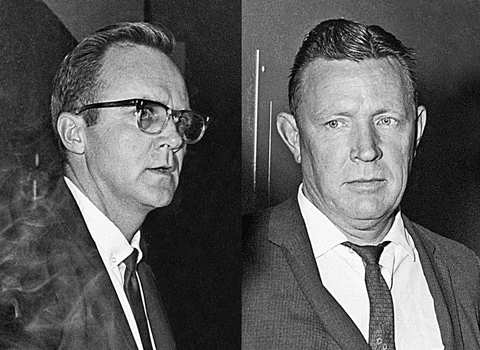 |
FBI SA Robert M. Barrett (left) and Capt. W.R. Westbrook (right) at Dallas Police Headquarters on November 22, 1963. (Tom C. Dillard Collection / The Sixth Floor Museum at Dealey Plaza)
By DALE K. MYERS
FBI Special Agent Robert M. “Bob” Barrett has been a hero in JFK conspiracy chat rooms and forums for a good twenty-six years now.
Barrett, who died in 2017 at the age of 91, was the FBI agent who claimed that Dallas police found Lee Harvey Oswald’s wallet at the Tippit murder scene – a slam dunk for Oswald’s guilt in that murder, according to Barrett.
Indeed, WFAA-TV news film, broadcast on television that fateful weekend, showed police looking at a wallet at the time Barrett was on scene.
How did Barrett know that the wallet belonged to Oswald? According to Barrett, Dallas police Captain William R. Westbrook asked Barrett at the scene if the names ‘Lee Harvey Oswald’ or ‘Alek J. Hidell’ meant anything to him? They did not.
Nine-minutes later, Oswald was arrested at the Texas Theater after a scuffle.
During the drive to police headquarters, one of the arresting officers, Detective Paul L. Bentley, pulled a wallet out of Oswald’s left-rear trouser pocket. The wallet contained identification in two names: ‘Lee Oswald’ and ‘Alek J. Hidell’. Oswald refused to say which was correct.
Barrett later charged that Bentley lied; that the wallet in evidence was recovered from the Tippit murder scene and not taken from Oswald’s pocket.
Diverging theories
Ever since this story surfaced – as a brief paragraph in James Hosty’s 1996 book Assignment: Oswald – Bob Barrett has been a hero to conspiracy theorists. To them, Barrett’s claims are the vital proof they’ve been searching for all these years; proof that police framed Oswald for the Tippit murder using a “planted” wallet.
Theories on how all this was accomplished – or even why a planted wallet was necessary – diverge at this point. Forget trying to get a coherent version out of any of these conspiracy theorists, or in particular, a version that is supported by actual facts. There isn’t one. Just accept their charges on faith – after all, the conspiracy theorists have! They have embraced the notion that their hero, Bob Barrett, was wrong about the slam dunk case against Oswald for the Tippit murder, but instead, unwittingly, and apparently, stupidly managed to provide them with proof of the big frame-up.
Those of you who know my work on this case, detailed in my 1998 book (which was revised and updated in 2013), With Malice: Lee Harvey Oswald and the Murder of Officer J.D. Tippit, also know that the bare-bones thumb-nail recap above is just the tip of the iceberg.
In addition to the original work I did on this case for my book, I’ve written several lengthy blog articles on the subject in the intervening years:
With Malice: The Tippit Murder 45 Years Later (2008)
and
Solving the Tippit Murder's Wallet Mystery: How the Truth Got Twisted into the Big Lie (2014)
More importantly, I’ve continued to work behind the scenes to fill in the gaps on how the wallet story got twisted into such a big mess.
We all know who’s responsible for all of the nonsense swirling around the Internet these days – conspiracy theorists like Joseph McBride, John Armstrong, Bill Simpich and others who are simply incapable of combining investigative truthfulness with rational thought.
And to be honest, Bob Barrett’s memory about this wallet issue, which I initially and rightfully questioned in my book, hasn’t fared very well over the years.
Fading memories
Those familiar with the wallet story know that the entire allegation about Oswald’s connection to the wallet filmed at the Tippit scene by WFAA-TV hinges on Bob Barrett’s recollection that he was asked at the scene (i.e., before Oswald’s arrest) about the names “Oswald’ and ‘Hidell’.
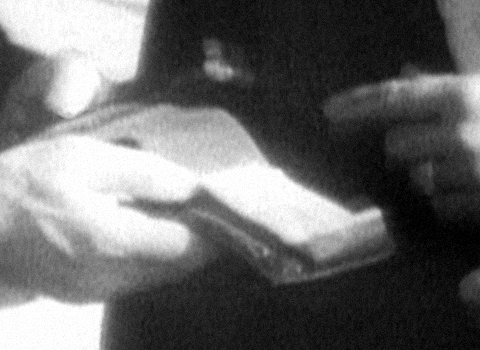 |
News film frame. (WFAA-TV Collection / The Sixth Floor Museum at Dealey Plaza)
You also know that there is no contemporary evidence – no eyewitness reports or testimony, no police reports, no television or radio reports (except the WFAA-TV broadcast in which the news cameraman himself, oddly enough, refers to the wallet as Tippit’s wallet) – that a wallet of any kind was “found” at the Tippit murder scene.
The only reason this story was worth one-second of any serious attention was the reputation of the man making the allegation – Bob Barrett.
To get at the truth of the allegation, I sought out and interviewed Barrett at length about his activities on November 22nd and despite his help we were unable to substantiate his recollection. I know it perplexed Mr. Barrett and it bugged the hell out of me too because I found him to be honest, candid, and amazingly accurate when it came to recalling the details of an afternoon more than three decades earlier.
Despite my personal belief that the wallet story, as Mr. Barrett told it, was exactly the way he remembered it, I could not in good conscience conclude that a wallet with Oswald’s name was found at the Tippit shooting scene. The very strong contemporary paper trail weighed against Barrett’s memory as did a mountain of eyewitness testimony I gathered.
One thing that still bothers me is Barrett’s recollection that he recalled “reporting” the story of the wallet at some time in the past – outside of his November 22, 1963, 302-report, which failed, by the way, to contain anything about the wallet (a critical oversight if Barrett’s recollection was correct).
In the years since my original investigation, several published newspaper interviews of Barrett have surfaced in connection with his later appointment as an investigator for the Southeastern Conference (SEC) of the NCAA.
I began to wonder if these interviews are what Barrett was remembering when he talked about other outstanding reports in 1996. If they are (and even if they are not), they underscore my original reluctance to accept Barrett’s claims based solely on his memory.
SEC investigator remembers
After his retirement from the FBI’s Alabama Office in July, 1978, Bob Barrett was named SEC Special Assistant for Enforcement under SEC Commissioner Boyd Whorter. In his new position, Barrett would investigate allegations and violations of conference schools and work closely with the NCAA investigative committees.
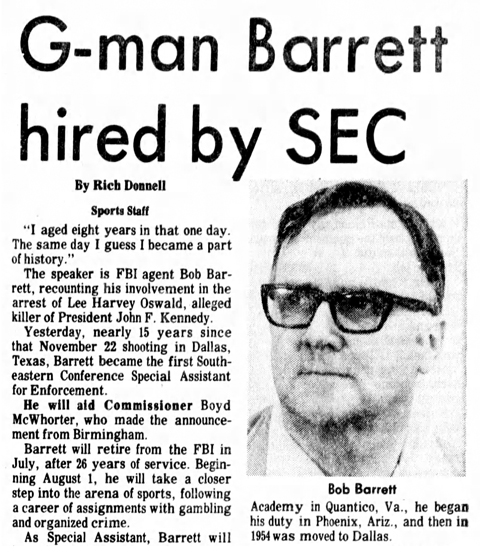 |
Newspaper clipping (Birmingham Post-Herald)
On March 21, 1978, upon the announcement of his pending appointment, an article appeared in The Birmingham Post-Herald entitled, “G-man Barret hired by SEC.” That article included a brief bio of Barrett including this:
Barrett, a graduate of Notre Dame, has been assigned to Birmingham since 1966. Upon leaving the FBI Academy in Quantico, Va., [in 1952] he began his duty in Phoenix, Ariz., and then in 1954 was moved to Dallas. The pinnacle of his career came the day Kennedy was shot in 1963.
“The day of the assassination I was at the Plaza, standing with Bill Decker, now deceased, who was sheriff of Dallas County. We heard a radio report that a policeman had been shot and Decker told me to check it out.
“The place was crowded, and by the time I got to the scene they were taking the body of Officer Tippit (J.D.) away. Then we heard another radio report that a suspicious character had been seen in the Texas Theater.
Being the last to arrive at the location of Tippit’s death, Barrett was one of the first to leave and arrive at the theater.
“We were standing close to the lobby, trying to talk the manager into turning on the house lights. There were about 10 officers in the immediate area and an Officer McDonald yells, ‘here he is.’
“I turned and saw Oswald lunge and grab somebody. I ran down the aisle in front of him. He was waving a pistol around and that was taken away from him. We didn’t know who we had. He was screaming about his civil rights. You might remember seeing Oswald with a black eye in later pictures. He got that during the tussle in the theater.” (bold-type added) [1]
In this published account, fifteen-years after the fact, Barrett doesn’t mention the wallet at the Tippit scene at all, although he does describe being at Oswald’s arrest and seeing Oswald waving a pistol around until “that was taken away from him.”
Barrett isn’t quoted as saying that he was the one who took Oswald’s gun from him, but it’s clear from the next article to appear that he certainly meant that.
The claim that Barrett took Oswald’s pistol from his hand, of course, is counter to what Barrett’s 1963 302-report says, “One of the officers took a .38 caliber snub-nosed revolver out of Oswald’s right-hand and handed it to Detective Carroll.” [2]
Barrett’s claim is highly dubious. There is a contemporary record that lays out the chain-of-custody of Oswald’s pistol – from Oswald’s hand to the police property room and Barrett is not part of it. In fact, retired Dallas Patrolman M.N. “Nick” McDonald, who by all accounts was the first one to grab the pistol (and from what I understand, never let it go until he handed it to DPD Detective Bob Carroll) had a good belly-laugh when I read him Barrett’s claim over the telephone in 1996.
More important, Barrett told me that on November 22 he served only as an observer. “I was an observer. Period. And no more, no less. I wasn't taking an active part in any investigation because it wasn't anything we had jurisdiction over. Remember I told you earlier, we always had this - this procedure where if something big happened we were supposed to go on the scene and observe it, offer our assistance, and be in a position to report what we saw and what happened.” [3]
If Barrett was charged with being only an observer at the scene, then he clearly would have crossed the line if he had reached into the melee in the Texas Theater and grabbed Oswald’s pistol, wouldn’t he?
Two months after the first article appeared announcing Barrett’s appointment as SEC investigator, a second article appeared, entitled, “The SEC Has Hired Itself a Real Cop.” In it, Barrett is identified as the man who “wrestled a .38-caliber pistol away from the man who was accused of murdering John F. Kennedy.” [4]
In the months that followed the appointment, Barrett was not only credited with having “participated in the arrest of JFK assassin Lee Harvey Oswald” [5] but also being the man “who arrested Lee Harvey Oswald”. [6] Of course, others were present, but historic credit for the arrest has always been given to the first officer to confront Oswald in the theater – M.N. “Nick” McDonald.
First mention of a wallet
Although Bob Barrett had not mentioned the wallet story to any newspaper people before 1984, he had told at least one person by early 1983.
Following his retirement from the Kansas Bureau of Investigation, where he worked following his stint with the FBI, James P. Hosty, Jr., appeared as a guest speaker at Baker University in Baldwin City, Kansas, at the invitation of Larry Haapanen, the chair of the Communications Department who also taught a class on the JFK assassination.
Haapanen’s notes, taken during Hosty’s lecture, record the first known public pronouncement that Oswald’s wallet was found at the Tippit crime scene:
Hosty then talked about Tippit shooting: number of shots, etc. Main point: he said that although it has never been mentioned in print, FBI S.A. Bob Barrett (a close friend) told him that LHO’s wallet was found at the scene of the Tippit shooting. Hosty said that the DPD had apparently written this up incorrectly in their reports. Hosty said that LHO’s behavior (shooting one policeman, trying to shoot another at Texas Theater) was ‘almost an admission of guilt.’ (underlined in original)
Haapanen later wrote: “You’ll notice that I underlined the part about the wallet; I underlined very few items in my notes, but that was obviously an important revelation.” [7]
Hosty would later include the claim in his 1996 book Assignment: Oswald, but for now, the revelation would remain dormant, known only to a handful of college students with perhaps only one – Haapanen – recognizing its significance.
More press
On November 22, 1983, on the occasion of the twentieth anniversary of the Kennedy assassination, Bob Barrett gave an interview to Karen Hartley of The Advertiser, a Montgomery, Alabama newspaper. The interview primarily dealt with Barrett’s theory that Oswald was actually aiming at Texas Governor John B. Connally when he hit Kennedy.
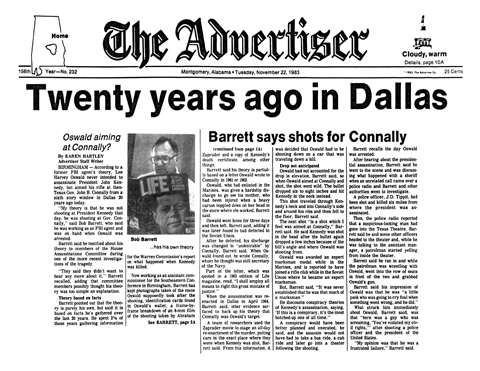 |
Newspaper clipping (The Knoxville News-Sentinel)
However, regarding the day of the assassination, Hartley wrote:
“After hearing about the presidential assassination, Barrett said he went to the scene and was discussing what happened with a sheriff when an unrelated call came over a police radio and Barrett and other authorities went to investigate. A police officer, J.D. Tippit, had been shot and killed six miles from where the president was assassinated. Then, the police radio reported that a suspicious-looking man had gone into the Texas Theater, Barrett said he and some other officers headed to the theater and, while he was talking to the assistant manager, a patrolman started yelling from inside the theater. Barrett said he ran in and while the patrolman was wrestling with Oswald, went into the row of seats in front of the two and grabbed Oswald’s gun. Barrett said his impression of Oswald was that he was ‘a little punk who was going to cry foul when something went wrong, and he did.’ What struck him immediately about Oswald, Barrett said, was that ‘here was a guy who was screaming, “You’ve violated my civil rights”’ after shooting a police officer and the president of the United States. ‘My opinion was that he was a frustrated failure,’ Barrett said.” (bold-type added) [8]
Again, Barrett claims that he was the one who took the gun from Oswald’s hand.
Second mention of a wallet
A few months later, in early January, another public statement appeared in print – this time a lengthy, rather detailed account – the longest to date – describing what Barrett did on November 22, 1963:
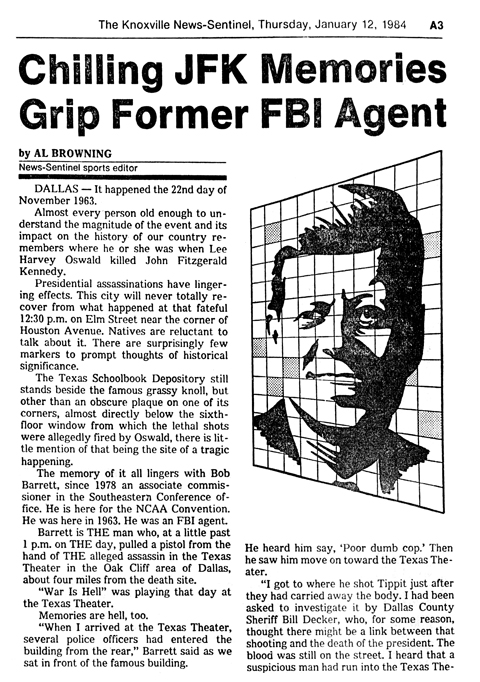 |
Newspaper clipping (The Advertiser)
“When I arrived at the Texas Theater, several police officers had entered the building from the rear,” Barrett said as we sat in front of the famous building.“I went in the front door and found them coming up the aisles, their backs to the screen, looking for a suspect we knew only as being 5-foot-7, 150 pounds and white, last seen wearing a plaid shirt and a tan jacket.“We knew he had run into a shoe store two doors down, then acting strangely, had run into the theater.“There were 15 or so patrons in the theater, mostly women and children, and I asked the assistant manager to turn on the house lights. It was his first day on the job, and he said he had no idea where the switch was.“I was standing at the back of the theater, where the seats start, when one of the officers, a man named McDonald, motioned to a man seated four rows below us, telling him to step out. The man, Oswald, reached for a pistol, McDonald screamed, ‘Here he is!’ and a wild scuffle started. There were about six or eight officers in the building and they converged on him.“In retrospect, I was crazy, but I went after Oswald from his front, while the others were at his back or his sides. He was screaming, ‘They are violating my civil rights!’ He was also waving the gun back and forth, right in my face. I reached out and grabbed it from him, and we finally got handcuffs on him and got him out of there.“I left Oswald with the police officers, then followed them downtown to file my report. When we got to the city jail, I heard a voice on the (police/FBI) radio say, ‘We have an APB (all-points-bulletin) for Lee Harvey Oswald, the prime suspect in the shooting of President John Fitzgerald Kennedy. And I heard the police officers ahead of me reply, ‘Cancel the APB. We have him in the back of our car.“It was the shortest APB in history.“When I returned to my office, I broke down and cried. Only then did it hit me that our president had been shot, and I had been involved in the capture of the man who had probably done it.”Barrett was involved with the case because he worked in the organized crime and gambling division of the FBI. He was at the Texas School Book Depository immediately following the assassination, when it was heard that Dallas police officer J.D. Tippit had been shot about two miles away.That location is less than a mile from 1026 Beckley St., where Oswald lived in a rented room. It was in that neighborhood that Oswald shot Tippit, who had stopped him for questioning.“This is merely conjecture,” Barrett said, “but Tippit probably got suspicious of Oswald when he found he had identification as both Lee Harvey Oswald and Alex Hidell. I say that because he left his wallet lying on the ground beside the police car after shooting Tippit.“The lady who lived in that house (Barrett pointed at one on the corner of 10th Street), Helen Markham, saw Oswald shoot Tippit. I interviewed her about it. On that corner (two houses away), a cab driver saw Oswald walking away from the scene. He heard him say, ‘Poor dumb cop.’ Then he saw him move on toward the Texas Theater.“I got to where he shot Tippit just after they had carried away the body. I had been asked to investigate it by Dallas County Sheriff Bill Decker, who, for some reason, thought there might be a link between that shooting and the death of the president. The blood was still on the street. I heard that a suspicious man had run into the Texas Theater and I went there.”Barrett remembers the FBI office suggesting that the Dallas Police Department transfer Oswald to the Dallas County Jail late Saturday night, the day after the assassination, not Sunday morning. Those words fell on deaf ears, or course, and Jack Ruby shot Oswald to death as he was being walked toward a police van at the Dallas City Jail.“It happened right here,” Barrett said, standing in a tunnel drive at the jail.“Ruby was standing among several news reporters. He stepped from the crowd and shot Oswald. A lot of people have said they saw that shooting live on television, but that is not true. It was an almost instant tape replay. All the major networks were carrying a memorial service for the president.“Also, a lot of people said Ruby never talked much about shooting Oswald. Geez! I talked to him about it. He was an emotional, volatile person. He liked President Kennedy. He adored Mrs. Kennedy. He said he did it because he did not want a murderer to go free, and he did not want Mrs. Kennedy to have to return to Dallas for the trial for Oswald.”Barrett, who said the FBI investigation of the assassination was aided considerably by a film taken by a bystander, Abraham Zapruder, is angered by talk of a conspiracy.“If a conspiracy was involved, which is not the case. It was the most amateurish in history,” Barrett said while standing on the grassy knoll. “If that is the best conspirators can do, we have nothing to fear. For one, it would be the craziest conspiracy in history, because the president was brought to the assassin, instead of the assassin going to the president.“Also, that was a cheap rifle used by Oswald, a 6.25-caliber Italian-made job that cost him $35 in a mail catalog. There was no decent plan for escape.”Furthermore, Barrett contends Kennedy was not the target Oswald was aiming at, rather Texas Gov. John Connally, who was seated in front of him. Connally was shot and wounded during the assassination.“Oswald had a hatred for Connally that went way back, to a dishonorable discharge Oswald got from military service.“The telling factor, though, lies in the three shots that were fired. Oswald missed with the first one. The second one would not have killed President Kennedy, only wounded him. The third one was lethal. We found parts of his skull in that grass across the street (about 40 yards from the shooting site).“Given the flight of the bullets that hit President Kennedy, plus the fact the motorcade was moving downhill and away from Oswald, the only way Oswald could have shot President Kennedy was by aiming at Connally. It would take a brilliant marksman to pull off a shot like that.”Barrett drove to 1026 Beckley, where Oswald lived. There was a sign on the front lawn: ‘Room for Rent’.” (bold-type added) [9]
Here, we see the first published account of Barrett’s claim that a wallet, containing identification for ‘Lee Harvey Oswald’ and ‘Alek Hidell’, was found at the Tippit shooting scene. Where and how the wallet was found is missing from this telling, as are details about how Barrett learned of the identification, but the basics of the claim are there – 20-years after the fact.
There are a smattering of inconsistencies, inaccuracies and exaggerations sprinkled throughout Barrett’s account – most are the kind you can attribute to the twenty-year gap between the events being described and the interview. [10]
One claim in particular, however, hints at the possibility that some of Barrett’s recollections are skewed versions of reality.
Case in point: Barrett claimed that he heard an APB put out on Oswald over the police radio. (In Barrett’s version, he either heard it over the Dallas police radio or the FBI radio, although how the Dallas police could have responded over an FBI radio is not explained.) This claim is similar to one made by retired Dallas police Detective Paul L. Bentley in 1996. I swabbed this story out pretty-well at the time and determined that there was no such broadcast. I suspect the story is a butchered version of what happened when Homicide Captain J. Will Fritz arrived at Dallas police headquarters and learned that the person he planned to have picked-up in Irving, Texas, for questioning was already in custody for the murder of Tippit. That subject was Oswald. Hence, “the shortest APB in history.”
More important to the issue here, Barrett himself told the Senate Select Committee on Intelligence in 1975, “I recall that when I got to the police department someone, identity unrecalled at this time, had told me that as the police car bringing Oswald and the officers from Oak Cliff was arriving at the police department, an all-points bulletin (APB) for Oswald was being made by the police department radio dispatcher. I recall the officer who was telling me this saying that it was probably the shortest ‘APB’ on record as the officers in the car immediately advised the radio dispatcher that the person being sought, Oswald, was in custody.” [11]
You can see right here, a good example of Barrett’s memory already mutilating details of that day. In 1975, Barrett recalled being told about the “shortest APB in history” by an unrecalled police officer back at Dallas Police Headquarters; but by 1984, Barrett remembers himself hearing over the radio the “shortest APB in history.”
Is it really that much of a stretch to believe that Barrett’s memory might’ve played havoc with the wallet story too?
Third mention of a wallet
Ten-months later, on November 22, 1984, Bob Barrett told The Tennessean sports writer John Bibb about his experiences, in a tape-recorded interview:
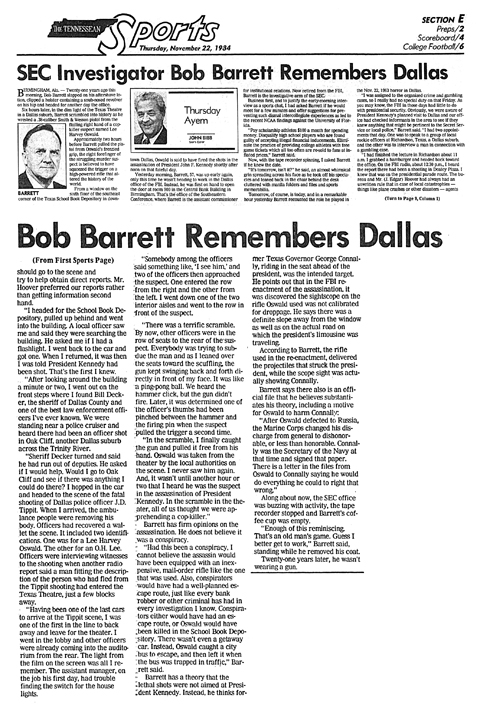 |
Newspaper clipping (The Tennessean)
“I was assigned to the organized crime and gambling cases, so I really had no special duty on that Friday. As you may know, the FBI in those days had little to do with presidential security. Obviously, we were aware of President Kennedy’s planned visit to Dallas and our office had checked informants in the area to see if they knew anything that might be pertinent to the Secret Service or local police,” Barrett said. “I had two appointments that day. One was to speak to a group of local rookie officers at Richardson, Texas, a Dallas suburb, and the other was to interview a man in connection with a gambling case.“I had finished the lecture in Richardson about 11 a.m. I grabbed a hamburger and headed back toward the office. On the FBI radio, about 12:30 p.m., I heard the report there had been a shooting in Dealey Plaza. I knew there had been a shooting in Dealey Plaza. I knew there was a presidential parade route. The Bureau and Mr. (J. Edgar) Hoover had always had an unwritten rule that in case of local catastrophes – things like plane crashes or other disasters – agents should go to the scene and try to help obtain direct reports. Mr. Hoover preferred our reports rather than getting information second hand.“I headed for the School Book Depository, pulled up behind and went into the building. A local officer saw me and said they were searching the building. He asked me if I had a flashlight. I went back to the car and got one. When I returned, it was then I was told President Kennedy had been shot. That’s the first I knew.“After looking around the building a minute or two, I went out on the front steps where I found Bill Decker, the sheriff of Dallas County and one of the best law enforcement officers I’ve ever known. We were standing near a police cruiser and heard there had been an officer shot in Oak Cliff, another Dallas suburb across the Trinity River.“Sheriff Decker turned and said he had run out of deputies. He asked if I would help. Would I go to Oak Cliff and see if there was anything I could do there? I hopped in the car and headed to the scene of the fatal shooting of the Dallas police officer J.D. Tippit. When I arrived, the ambulance people were removing his body. Officers had recovered a wallet at the scene. It included two identifications. One was for a Lee Harvey Oswald. The other for an O.H. Lee. Officers were interviewing witnesses to the shooting when another radio report said a man fitting the description of the person who had fled from the Tippit shooting had entered the Texas Theater, just a few blocks away.“Having been one of the last cars to arrive at the Tippit scene, I was one of the first in the line to back away and leave for the theater. I went in the lobby and other officers were already coming into the auditorium from the rear. The light from the film on the screen was all I remember. The assistant manager, on the job his first day, had trouble finding the switch for the house lights.“Somebody among the officers said something like, ‘I see him,’ and two of the officers then approached the suspect. One entered the row from the right and the other from the left. I went down one of the two interior aisles and went to the row in front of the suspect.“There was a terrific scramble. By now, other officers were in the row of seats to the rear of the suspect. Everybody was trying to subdue the man as I leaned over the seats toward the scuffling, the gun kept swinging back and forth directly in front of my face. It was like a ping-pong ball. We heard the hammer click, but the gun didn’t fire. Later it was determined one of the officer’s thumbs had been pinched between the hammer and the firing pin when the suspect pulled the trigger a second time.“In the scramble, I finally caught the gun and pulled it free from his hand. Oswald was taken from the theater by the local authorities on the scene. I never saw him again. And it wasn’t until another hour or two that I heard he was the suspect in the assassination of President Kennedy. In the scramble in the theater, all of us thought we were apprehending a cop-killer.” (bold-type added) [12]
Here, in this second published account, we see that Barrett has scrambled the names allegedly found in the wallet. Rather than the wallet containing identification for ‘Lee Harvey Oswald’ and ‘Alek Hidell’, as stated previously, now Barrett says the names were ‘Lee Harvey Oswald’ and ‘O.H. Lee’. [13]
The ‘O.H. Lee’ reference was not on any identification that Oswald carried – it was only used once – to sign the register when he rented a room at 1026 N. Beckley.
This might seem like a simple mix-up, but it cuts to the heart of whether Barrett’s memory about the wallet story is accurate.
Back at the station
After Oswald’s arrest, FBI SA Bob Barrett drove to Dallas police headquarters.
“I proceeded to the Dallas Police Department where I went to the office of Captain Westbrook to offer what assistance I could in connection with the preparation of the arrest report concerning Oswald,” Barrett told investigators. “I did this because Oswald had made some statements about his civil rights being violated, and I wanted the report to show that an FBI agent had been present during the arrest and would be in a position to furnish details concerning the arrest and these allegations.” [14]
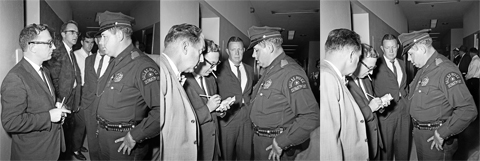 |
Barrett and Westbrook. (Tom C. Dillard Collection / The Sixth Floor Museum at Dealey Plaza)
A series of three Dallas Morning News photographs, taken by Tom C. Dillard, show FBI SA Barrett and Dallas Police Captain W.R. Westbrook standing in the third-floor corridor outside the Homicide & Robbery Bureau as Dallas Morning News reporter James Ewell interviewed arresting officer M.N. “Nick McDonald. [15]
One of these photographs was published in With Malice. [16] The identities of Barrett and Westbrook are revealed here for the first time.
Barrett and Westbrook then proceeded down the corridor to the Personnel Office, the same place where the arresting officers – Gerald L. Hill, Paul L. Bentley, Bob Carroll, and M.N. McDonald – gathered to make out their arrest report.
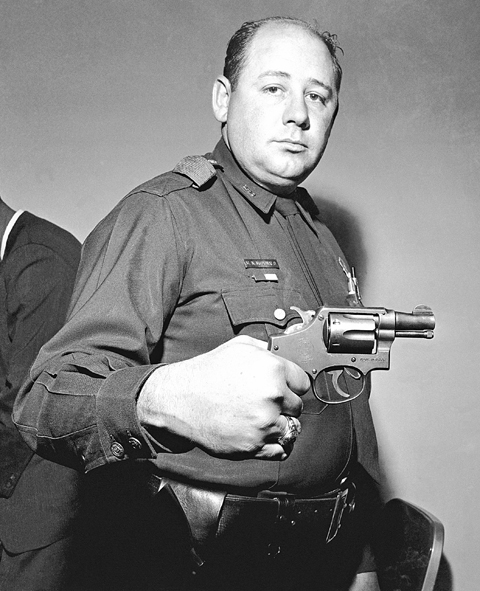 |
Nick McDonald holding Oswald's revolver in the Personnel Office. (Ferd Kaufman / AP)
While there, Barrett observed Oswald’s .38 caliber snub-nosed revolver and was shown the six cartridges taken from the weapon, including one that had an indentation on the primer. Barrett also reported speaking to Officer M.N. McDonald about the primer indentation and how Oswald had pulled the trigger in the theater but the gun did not fire. [17]
It was also likely that Barrett heard Detective Paul Bentley talking about the “shortest APB in history” – both men known to have been in the Personnel Office at this time. [18]
In another relevant incident, Lieutenant Jack Revill, who was in charge of the Dallas police criminal intelligence unit which monitored organized crime and political radicals, was heading to his office to make out a report.
Revill had just been told by his supervisor Lt. Pat Gannaway to write a report on his basement encounter with FBI agent James P. Hosty, Jr. (Hosty had allegedly blurted out that the FBI had Oswald in their security files, that they knew he was in Dallas and that “he was capable of [the assassination].”)
While on the way to his office, Lt. Revill bumped into detectives Bob Carroll and E.E. Taylor, who were standing in the hall with FBI agent Bob Barrett. The three men gave Revill details about the arrest of Lee Harvey Oswald. Detectives Carroll and Taylor added that Oswald lived at 605 Elsbeth Street (sic) in Dallas and that he was a “prime suspect in the assassination of President Kennedy.” [19]
Lt. Revill later used the address in the report he wrote on his basement encounter with Hosty.
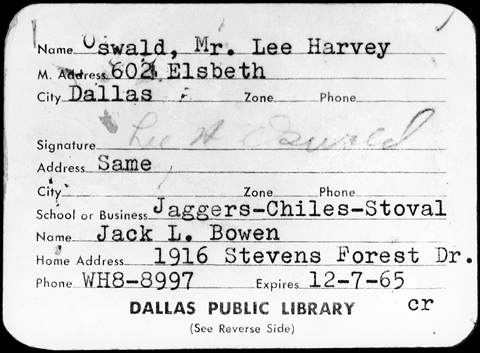 |
Oswald's library card. (DMARC)
The address, of course, originated from a Dallas Public Library card Oswald had in his wallet at the time of his arrest. During a WFAA-TV interview on Saturday, November 23rd, Detective Paul Bentley told a reporter that after he removed the wallet, Oswald was asked “if he was still living at the Elsberry (sic) address, and he says, ‘Well, you find out for yourself.’” Although the address was an old one, the library card didn’t expire until 1965. Since this was the only card in Oswald’s wallet with a Dallas address, the police probably believed this was Oswald’s current address. [20]
“I don’t remember that happening,” Barrett told me in 1996. “I don’t remember seeing Jack [Revill] that day at all.” [21]
Perhaps. But Bob Barrett did work closely with Lt. Revill, who worked out of the DPD’s Fair Park office.
“I worked very, very close with Jack Revill, and H.M. Hart, and that bunch of fellows,” Barrett told me, “who had their own office out of Fair Park. They weren't even in the Police Department office downtown. I was there practically every morning, that would be one of the first places I’d go.” [22]
Eventually, Barrett conceded that the hallway encounter with Revill, Carroll and Taylor could have happened, but he just didn’t remember it. Ah, yes – memory. [23]
The key point here is that there is little doubt that Bob Barrett was aware that the man he saw arrested in the Texas Theater – Lee Harvey Oswald – had been identified as a Book Depository employee, and consequently had been linked to the JFK assassination, shortly after arriving at Dallas police headquarters.
All of this information had been gleaned from the arresting officers who themselves had gotten it during the ride back to police headquarters and in the minutes following Captain J. Will Fritz’s arrival at his office. The fact that their prime suspect had two sets of identification in his wallet was the talk of the department.
And yet, Bob Barrett claims that despite the fact that he returned to police headquarters, was photographed with Captain Westbrook in the third-floor corridor, retired to Westbrook’s office with him, mingled with arresting officers in Westbrook’s office as they wrote their arrest report, and lingered at police headquarters long enough to learn that Oswald was a prime suspect in the JFK assassination – he never spoke with Captain Westbrook or anyone else about the contents of Oswald’s wallet?
“The only time I spoke to Westbrook at any time,” Barrett told me in 1996, “was at the murder scene. I may have said something about, ‘Well, I want to see how that report’s written’ or ‘I want to make sure that report is written so there’s no civil rights violation alleged.’ But there was no conversation at the police department about the names ‘Oswald’ and ‘Hidell’ or any contents of a wallet.” [24]
Frankly, under the circumstances, I find that hard to believe.
But to give the devil his due, it should be noted that although Barrett undoubtedly learned that the arresting officers had determined Oswald’s name by looking through his wallet, and even that he had two sets of identification – ‘Oswald’ and ‘Hidell’ – Barrett may have been unaware that the wallet that police were talking about had been removed from Oswald’s pocket after his arrest.
Consequently, it’s quite possible that Barrett left police headquarters on Friday afternoon under the false impression that police had recovered Oswald’s wallet at the scene of the Tippit shooting.
Back to the future
Zip forward twenty-years and you have Barrett combining two facts – (1) seeing Westbrook at the Tippit shooting scene with a wallet and (2) being told later that Oswald had two sets of identification in his wallet.
Barrett could never understand why the police would not fess-up about finding Oswald’s wallet at the Tippit shooting scene – which he considered part of the slam-dunk case against Oswald for killing Tippit.
In later years, he turned to accusing Paul Bentley (after Bentley’s death), of lying about where the wallet came from.
But I have spoken with Bentley at length about the wallet taken from Oswald after his arrest and I can assure you, any concerns I might have had melted away in Bentley’s presence. In my opinion, Bentley was simply incapable of fabricating a story about recovering Oswald’s wallet in the car after his arrest. [25]
Nor would Bentley have had any reason to fabricate a story. Unlike Barrett, Bentley had a large contemporary record that backed-up his recollection of events, and there has never been any reason to question it.
No, I’m afraid Barrett is stuck with his memory of the events and there’s nothing he can do to shift the blame to someone like Paul Bentley.
Assessing the evidence
My exhaustive study of the wallet that was captured on WFAA-TV news film at the Tippit crime scene established two inescapable facts:
The wallet on news film is a similar-styled wallet, but not identical to the one pulled from Oswald’s pocket and housed at the National Archives. [26]
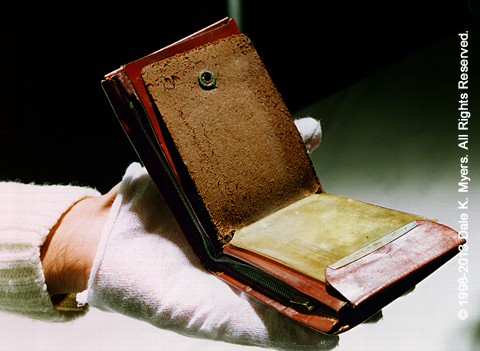 |
Oswald's arrest wallet. (© 1998-2013 Dale K. Myers. All Rights Reserved.)
Only one person – DPD Reserve Sergeant Kenneth H. Croy – ever claimed to know the origin of the wallet caught on film. According to Croy, an unidentified male, who recovered the wallet and turned it over to him, said Tippit’s killer tossed it in the shrubs a short distance from the scene as he fled. (It is not known if the unidentified male actually saw Tippit’s killer toss the wallet, or it was simply recovered along the killer’s escape path.) Croy said the wallet had seven ID’s in it, but none had any photographs or the name Lee Harvey Oswald on them. Asked how he made the connection between Oswald and the wallet, Croy said he was told Tippit’s killer tossed it and after Oswald was arrested for the murder, he assumed the connection. [27] While Officer Croy’s recollections do offer details, however nebulous, about the origin of the wallet depicted in the WFAA-TV film footage, Croy’s account conflicts fundamentally with Barrett’s central argument – that the identification in the wallet at the scene contained two names, Lee Harvey Oswald and his known alias Alek James Hidell.
Neither Croy or Barrett mentioned the discarded wallet in their contemporary reports. Barrett’s claim first surfaced 19-years after the fact; Croy’s 39-years after the fact. [28]
There’s lots more to this story which you can explore in With Malice and elsewhere on this blog site. Here’s what I’ve come to believe:
Two key facts weigh against Barrett’s recollection that the names “Oswald” and “Hidell” were discovered in the wallet found near the Tippit shooting scene.
First, if a wallet containing identification for ‘Lee Oswald’ and ‘Alek Hidell’ (the name Oswald used to ordered the rifle that killed Kennedy) had been found at the Tippit shooting scene, it certainly would have been trumpeted by the world press that very afternoon, held up for the world to see by the Dallas police that weekend, and served as prima facie evidence in the Warren Commission’s case against Lee Harvey Oswald.
Instead, not one word about Oswald’s wallet being found at the Tippit murder scene was ever published in the newspapers, or broadcast on radio or television, even though there were several radio and television reporters at the scene that afternoon.
Even conspiracy theorists who fancy the wallet filmed by WFAA-TV as a plant, left behind at the murder scene by Tippit’s “real killer” in order to frame Oswald, would have to admit that police would have no reason to hold back the discovery of a discarded wallet with Oswald’s name in it the night of the assassination; and even less reason for the press to ignore such an important detail. That, in and of itself, is a strong argument against Barrett’s memory.
Second, and perhaps more significantly, Barrett, who had a reputation within the bureau for writing highly detailed after-action reports, containing information other FBI agents wouldn’t bother to have included, [29] didn’t mention anything about police finding Oswald’s wallet at the Tippit shooting scene in the report he filed that day. [30]
And Barrett again failed to mention it when he had the opportunity in 1975. Testifying about his activities on the day of the assassination, including at the Tippit murder scene, Barrett assured Senate Select Committee members that the report he filed on November 22, 1963, “was my best recollection, [written] at the time of the events I had seen and observed that day.” [31]
The wallet issue ultimately boils down to one of credibility. Bob Barrett always felt that he had “reported” the wallet somewhere along the line and now it looks like that report wasn’t anything official but rather a collection of newspaper interviews in which Barrett’s understandably faulty memory is on display.
Selling a lie
The wallet story has been kicked around for the better part of twenty-six years now. Conspiracy advocates, who champion the theory that Oswald was innocent of the Tippit shooting and who see the wallet story as evidence of “a plant” to frame Oswald for the killing, have predictably run with Barrett’s claim like a largemouth bass running out a fishing line.
By mixing fantasy, supposition and innuendo with fact, they have collectively turned the entire wallet story into something resembling FUBAR. [32] You can thank Farris Rookstool, John Armstrong, Bill Simpich, Joseph McBride and a whole host of fatheads and mental cases who wouldn’t know a fact from a fart.
Frankly, they can’t help themselves. The only way they can sell a lie is with more lies. Believe me, it doesn’t take long before the crap gets pretty deep. And so do the attacks on my character, reputation and life works as I attempt to separate fact from fiction in the Tippit murder.
Look, I can take the insults. It’s easy – I ignore them and the people who spread them. But for the love of god, have some mercy on the poor, naïve souls who only want to know what happened on November 22, 1963. Trust me, they can figure it out – without all the bullshit.
Bottom line
As I wrote in With Malice twenty-four years ago: “There are a sprinkling of understandable inaccuracies throughout Barrett’s thirty-year-old recollections, which raises the possibility that Barrett – despite his insistence – may be mistaken about where he was when Westbrook asked him about the names Hidell and Oswald.
I was being as kind as I could considering the late Robert M. “Bob” Barrett’s well-deserved lifelong reputation for honesty and integrity.
But given the latest information, I might revise “possibility” to “strong possibility.”
If something new surfaces that alters my view, you can be sure that you’ll read about it here first. [END]
Footnotes
[1] Donnell, Rich, “G-man Barrett hired by SEC,” Birmingham Post-Herald, Birmingham, Alabama, Friday, March 31, 1978, Section B, p.1
[2] CD5, p.85 (Robert M. Barrett’s 302-report, November 22, 1963, p.2)
[3] Author’s interview of Robert M. Barrett, February 23, 1996, p.11
[4] Lapides, George, “The SEC Has Hired Itself a Real Cop,” The Memphis Press-Scimitar, Memphis, Tennessee, Wednesday, May 10, 1978, p.42
[5] Cronauer, Bill, “What LSU lacks in class it makes up in ability,” St. Petersburg Times, St. Petersburg, Florida, Friday, March 2, 1979, Section C, p.4
[6] Visser, Lesley, “The pirating of an unguided athlete,” The Boston Sunday Globe, Boston, Massachusetts, Sunday, June 14, 1981, p.86
[7] Email, Larry Haapanen to Todd W. Vaughan, July 12, 2020, 6:36 p.m., p.1
[8] Hartley, Karen, “Twenty years ago in Dallas,” The Advertiser, Tuesday, November 22, 1983, Section A, pp.1-2
[9] Browning, Al, “Chilling JFK Memories Grip Former FBI Agent,” The Knoxville News-Sentinel, Thursday, January 12, 1984, Section A, p.3
[10] [Note: Once again, Barrett claims that he pulled the pistol from Oswald’s hand while police were wrestling with him – an unbelievable claim given the record. Barrett’s reference to Oswald wearing a “plaid shirt” was not in the original description broadcast by police on November 22nd and sounds like his own added detail. The house Barrett refers to as being the home of Helen Markham cannot be correct, since Markham lived on the southwest corner of Ninth and Patton – not on Tenth at Patton. Barrett also claimed that no television network broadcast the Jack Ruby shooting of Oswald live, however, one network did – NBC-TV. The two others, CBS-TV and ABC-TV used instant replay and news film to show what happened to their audiences. Oswald’s rifle was a 6.5mm Italian Mannlicher-Carcano purchased for about $22 dollars (including shipping) from a mail-order house in Chicago – not $35 dollars. Barrett’s theory that Oswald was shooting at Connally and not Kennedy is silly on its face.]
[11] FBI RIF 124-10167-10399 (Senate Select Committee on Intelligence Activities, Interview of Robert M. Barrett, December 17, 1975, p.11)
[12] Bibb, John, “SEC Investigator Bob Barrett Remembers Dallas,” The Tennessean, Thursday, November 22, 1984, Sports, Section E, p.1, 9
[13] [Note: Barrett told me something similar in 1996: “…he had identification for Oswald and for Hidell and I believe O.H. Lee was in there too, but I'm not real certain of that.” (Author’s interview of Robert M. Barrett, February 15, 1996, p.4)]
[14] FBI RIF 124-10167-10399 (Senate Select Committee on Intelligence Activities,
Interview of Robert M. Barrett, December 17, 1975, p.11)
[15] Tom C. Dillard Collection / The Sixth Floor Museum at Dealey Plaza, 1994.003.0026.0001; 1994.003.0026.0002 and 1994.003.0028.0001
[16] Myers, Dale K., With Malice: Lee Harvey Oswald and the Murder of Officer J.D. Tippit, Oak Cliff Press, 2013, p.261 (Tom C. Dillard Collection / The Sixth Floor Museum at Dealey Plaza, 1994.003.0026.0001)
[17] CD5, p.85 (FBI Report of Robert M. Barrett, November 22, 1963)
[18] Author’s interview of Robert M. Barrett, February 15, 1996, p.12 [Note: Barrett recalled that one of the officers who was in the car – he thought it might have been Bob Carroll (who was also in the Personnel Office at the same time as Barrett) – talked about the “shortest APB in history”. I thought it more likely that it was Bentley who told the story, since he told the same story to me in 1996.]
[19] 5H40-42 (WCT of Jack Revill, May 13, 1964) (Note: The address on the card is 602 Elsbeth, not 605 as reported by the officers.)
[20] Interview of Paul Bentley and M.N. McDonald, WFAA-TV Collection, November 23, 1963, 2:18 p.m., PKT-21 (Timecode: 32:20 to 39:49) / The Sixth Floor Museum at Dealey Plaza (Note: The address on the card is 602 Elsbeth, not 605 as reported by the officers.)
[21] Author’s interview of Robert M. Barrett, October 30, 1996, p.9
[22] Author’s interview of Robert M. Barrett, February 15, 1996, p.19
[23] Author’s interview of Robert M. Barrett, October 30, 1996, p.9
[24] Author’s interview of Robert M. Barrett, March 7, 1996, pp.1-2
[25] Author’s interview with Paul L. Bentley, March 13, 1996, pp.1-17
[26] Author’s photos of Oswald’s arrest wallet FBI Exhibit B-1; original WFAA-TV news film
[27] Author’s interviews of Kenneth H. Croy, July 20 and August 5, 2009
[28] Note: Croy’s claim first appeared in John Armstrong’s 2003 book Harvey and Lee: How the CIA Framed Oswald - six years after the wallet story appeared in James P. Hosty’s book Assignment: Oswald and four years after additional details were published in the first edition of this volume. Citing a 2002 interview by long-time conspiracy theorist Jones Harris, Armstrong wrote that an unidentified civilian handed Croy a wallet that was “later found to contain identification for Lee Harvey Oswald and Alex Hidell.” (Harvey and Lee, p.856) Yet, Croy told this author that the wallet he was given contained seven IDs in as many names and none of them were Oswald.
[29] Interview of William K. Teigen, January 28, 1999, p.2 [Note: Teigen, a former FBI agent, stated that in the course of the four years he was partnered with Barrett, they discussed the Tippit shooting, the assassination in general, and Barrett’s work on the case. According to Teigen, Barrett recalled the events as a blur and at no time did he ever mention the police finding a wallet with identification in the name of Oswald or Hidell. Teigen believed that Barrett’s later recollections were likely a combination of the blurred events he recalled, with a mix of other information implanted upon them.
[30] CD5, pp.84-85 (FBI Report of Robert M. Barrett, November 22, 1963)
[31] FBI RIF 124-10167-10399 (Senate Select Committee on Intelligence Activities, Interview of Robert M. Barrett, December 17, 1975, p.10)
[32] Military slang dating back to at least World War II, and further popularized by the 1998 movie “Saving Private Ryan”, which translates as: Fucked/Fouled Up Beyond All Repair/Recognition.





12 comments:
It's fascinating to see the pre-1996 accounts which reference the mystery wallet!
This excellent analysis should end the exhausting debate over this issue, but of course it won't. The desire for this to be smoking gun "planted" evidence is so strong among conspiracy advocates that rational analysis will never prevail.
I'm especially intrigued with your 2009 interview with Croy, he seemed to claim a lot of knowledge of the wallet's origin and contents (seven different IDs?). Did his memory on these points come across to you as accurate?
Paul C - I suppose it was as accurate as it could be forty-six years after the fact. Think about that. Four-and-a-half-decades! Pick the biggest day of your own life forty-six years ago. How much detail do you remember? Croy's memory on all points was sparse and vague, as expected.
Dale,
Your article is well-written and accurate.
Many of us come to different conclusions from the same large body of evidence.
In particular, Barrett and Croy's observations differ from your conclusions.
If you had more confidence in your evaluation, you would not be labeling people who disagree with your analysis as people who run with "lies" and trying to marginalize them with statements like they "wouldn't know a fact from a fart".
It's this kind of rhetoric that has taken our society into a dark box canyon. It's too bad. You can do better than this. - Bill Simpich
Feel better, Bill? Your wackadoodle writings on this subject not only preceded *my* remarks but also betray your comments above.
For instance, you claim that “Many of us come to different conclusions from the same large body of evidence,” as if we’re all sticking to the same fact-sheet. But that’s not true, is it? Here’s just a small sample:
In December, 2020, you wrote: “I think [Officer] Croy brought [the wallet recovered at the Tippit scene] with him.” Based on what? Your imagination? Croy said it was given to him by an unidentified citizen, but you don’t accept that fact, do you? Fine, that’s your opinion.
You also wrote, “For years, I touted Bob Barrett as a truth-teller… Now, I don't believe Barrett. I think he is the worst kind of xxxx - on the Tippit wallet and many other things…. I'll admit this, I am embarrassed that I ever believed Barrett.” Again, more opinion.
And yet above, you commented that “Barrett and Croy’s observations differ from your conclusions” as if *my* opinion, based on the available facts, was a bad thing. You don’t see the irony, do you? If you did, you wouldn’t have written something so silly.
Opinions are everywhere, Bill. Nobody cares. Stick to the facts and we’ll be in great shape.
Finally, I get that you don’t like when I call out conspiracy-mongers like you for what they’ve said, written and promoted for years. I don’t particularly enjoy doing it, to be honest. It would be so much easier to just look the other way and go about my business. But I can’t do that.
Apparently, you prefer a world where crazy-talk gets impunity and denigrating the names of deceased police officers is all part of the fun of promoting the grand-conspiracy.
And yet, you believe that *I’m* the one leading “our society into a dark box canyon” by calling out the nuttiness. The way I see it, the shoe is on the other foot. Just my opinion.
Both of us have opinions, based on our analysis of the facts.
Name-calling is what happens when someone lacks confidence in their belief system.
Why not engage with people who disagree with you with respect? Why not stick to the facts?
Mr. Simpich – Yes, indeed, why *don’t* you stick to the facts! That’s *my* point. Your writings and speeches include a liberal amount of fact-alteration followed by opinion and analysis, which I submit is flawed at the onset because it is *not* based on facts but rather your own re-rendering of the “facts.”
This I find abhorrent in the wake of years of similar dissertations that have muddied the waters of this case. (Anyone interested in what I’m talking about can find your posted assertions elsewhere.) In short, in my opinion, you’re not helping clarify history.
As for my writing style, I found your attempt to deflect (“Name-calling is what happens…”) rather cute.
The way I see it, describing someone’s thinking in a derogatory manner in the middle of an otherwise sound argument is not a fallacious ad hominem attack aimed at deflecting from the point of the argument.
On this blog, I dissect the so-called “factual” claims of those I disagree with, after which I opine on how I see those so-called “factual” claims. This is an opinion blog after all. Most of the time, the efforts of those allegedly clarifying history are not pretty. Hence, our disagreement. As far as my opinion, I “call” them as I see them.
Finally, I don’t have much respect for *anyone* who knowingly chooses to ignore the facts in such a well-documented case as this, regardless of their motivation.
As I understand events, the ambulance arrived on the scene within a minute of being called. Could Barret have made it to the scene of the Tippit murder fast enough to have seen the ambulance there?
A second ambulance is known to have shown up at the Tippit scene after the officer's body had already been transported to Methodist Hospital by the Dudley Hughes ambulance (Unit 602). This second ambulance is no doubt the one Barrett refers to. The dispatcher later reported that three ambulances responded to the shooting.
But Barrett said he saw them loading the body!
Anonymous - No, Barrett didn't see the ambulance attendants "loading the body". Barrett told me that the ambulance was off in the distance, leaving the scene, when he arrived. The ambulance he referred to couldn't have been the Dudley Hughes ambulance since it left with Tippit's body at 1:20 p.m. and Barrett didn't arrive on scene until about 1:42 p.m. All of this is detailed in my book "With Malice."
Barrett said “When I arrived, the ambulance people were removing his body.” How do you explain that?
Anonymous - I don't have to explain anything. As you *must* know, Barrett also said in 1984: "I got to where he shot Tippit just after they had carried away the body." So which is it? Did he arrive in time to see the body carried away or not? I swabbed Barrett out pretty good on this issue and it was clear he arrived *after* - long after, as a matter of fact - Tippit's body was removed from the scene. This conclusion is supported by his own admissions to me, to reporters, and the clear, concise, documented record (including the DPD radio recordings, to name just one) on this issue. If you had the courage of your convictions, you wouldn't post on this blog as "anonymous". I suspect that you're a pot-stirrer with little grasp of the facts of this case and zero interest in the truth. Why else would you post a comment/question on this blog in such an accusatory manner? Go play somewhere else.
Post a Comment